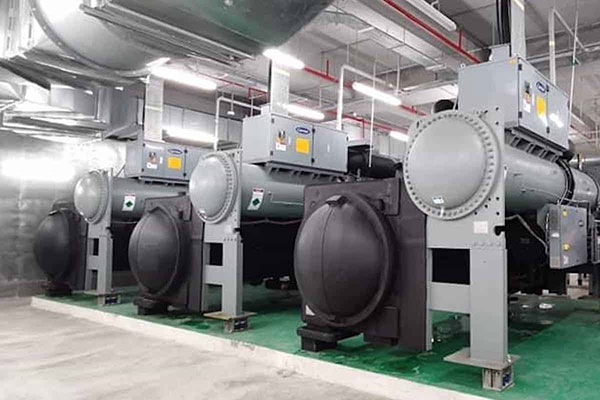Chilled Water Treatment
Chilled water treatment refers to the process of treating water that is used in chilled water systems, such as air conditioning and refrigeration systems. The goal of chilled water treatment is to maintain the quality of the water and prevent corrosion, scaling, and biological growth in the chilled water system.

The chilled water treatment process typically includes the following steps:
Pretreatment: This step involves removing impurities such as sediment, debris, and dissolved gases from the water before it enters the chilled water system. This is usually accomplished through the use of filters, screens, and chemical treatment. Depending on the source of the water, pretreatment may include processes such as coagulation, flocculation, sedimentation, and filtration.
pH adjustment: The pH of the water is adjusted to the appropriate level for the specific chilled water system. The pH should be in the range of 7 to 9 for most systems to prevent corrosion. If the pH is too low, chemicals such as sodium hydroxide or potassium hydroxide may be added to increase the pH. If the pH is too high, chemicals such as sulfuric acid or hydrochloric acid may be added to decrease the pH.
Scale control: Scale can form on the surfaces of the chilled water system due to the precipitation of dissolved minerals in the water. Scale control is achieved by adding chemicals that inhibit the precipitation of these minerals, such as phosphonates, polymers, and citrates.
Microbial control: Microorganisms can grow in the chilled water system, which can lead to fouling, corrosion, and heat transfer problems. Microbial control is achieved by adding biocides, such as chlorine, to the water to kill these microorganisms.
Continuous monitoring: Regular monitoring of the water quality and chemical treatment levels is important to ensure that the chilled water system is operating efficiently and effectively. This includes monitoring pH, conductivity, total dissolved solids, and other parameters.
Blowdown: Chilled water contains dissolved solids, which will accumulate over time. To maintain the desired level of water quality, a portion of the water is removed through the process of blowdown. This water is replaced with make-up water, which must be pretreated before entering the chilled water system.
The advantages of chilled water treatment are:
- Improving the efficiency of the chilled water system by removing impurities, controlling pH, and preventing scaling
- Maintaining the quality of the water, ensuring that it is safe and suitable for its intended use
- Prolong the life of the chilled water system and prevent corrosion, scaling and bacterial growth
- Compliance with regulatory guidelines and standards, avoiding penalties and fines
- Enhanced safety by reducing the risk of chilled water system failure or breakdown
- Improved energy efficiency by reducing the load on the cooling system, which can lead to lower energy consumption and cost savings.
It is important to note that the specific treatment processes and chemicals used will depend on the type of chilled water system, the water source, and the specific operating conditions. A qualified water treatment specialist should be consulted to determine the appropriate treatment program for a specific chilled water system.

Neo Nir Engineering
HOUSE OF WATER TREATMENT
Our ability to meet the needs and satisfy our customers is facilitated by our team of water treatment professionals and our more than 20 years of experience. We are able to provide exceptional outcomes because of our high-performance product line and our solution-focused onsite and offsite workforce working together.
Address :
Plot No. A36 City Industrial Estate
Near Swami Narayan Temple
Udhna-Navsari Main Road
Surat, Gujarat, India – 394 210
Phone : 91-261-2312716 / 2364251
Neo Nir Engineering
© Copyright 2023 Neo- Nir Engineering. All Rights Reserved Designed and maintained by Creative Kshetra
